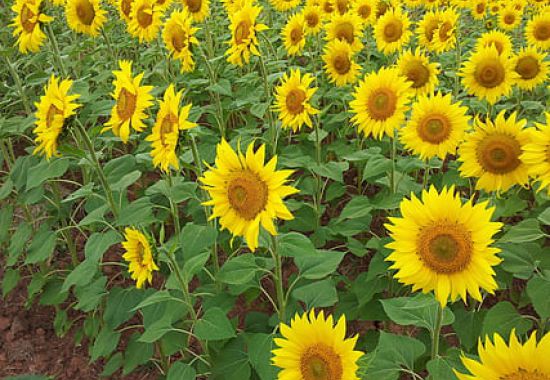Description
The sunflower is an annual herbaceous plant, with a very deep taproot that can reach 2 meters deep. Its secondary root system is the one that absorbs most of the nutrients, and they are concentrated in the first 30cm of soil. Its stem is cylindrical, erect and semi-woody, and can reach 3 meters in height. Its leaves are deep green, heart-shaped, serrated and with a rough surface. Its chapter-shaped inflorescence is 15 to 25cm in diameter. In it there may be 700 to 2,000 flowers, which are hermaphrodites, although fertilization is usually entomophilous and alogamous (by other plants). Its fruit, from which oils are extracted or sold roasted, is a small achene or pipe with a woody epidermis.
In Spain approximately 690,000 hectares of sunflower are cultivated, in which 950,000 tons are produced annually. Spanish sunflower production is concentrated in Castilla and León (280,000 ha), Andalusia (201,000 ha) and Castilla-La Mancha (169,000 ha)

Soil
Sunflower is not too demanding on the soil and does not need a specific texture to have acceptable yields. You only need a good depth of soil and good drainage to avoid waterlogging. It grows acceptably at a pH of 5.8 to 8, but its optimum is at a pH of 6.2-7. It is not very tolerant of soil salinity, like corn.
PH
Salinity
Quality
Temperature
The optimum growth temperature for sunflower is between 18 and 22ºC. Higher temperatures during the seed formation phase decrease the quality of the final oil obtained. If at the beginning of its growth the plant grows at higher temperatures, it will have better resistance and lower crop losses.
Irrigation
Its water needs depend on the moisture present in the soil. By having a deep root system, it is possible to grow it without too much watering as long as the rains supply the crops water needs. They need approximately 600 to 800mm of water per year.
Irrigation properties
Varieties
The sunflower varieties used are highly variable as they are commercial hybrids with different characteristics. Their choice depends on the needs of the farmer, since they can be classified by height, duration of the cycle, fat content of the pipes or tolerance / resistance to various pathogens and pests.
Other similar crops